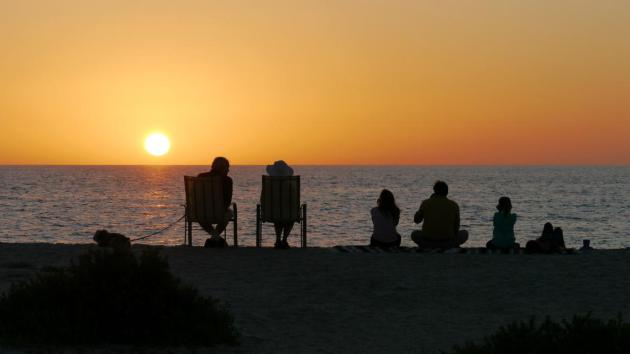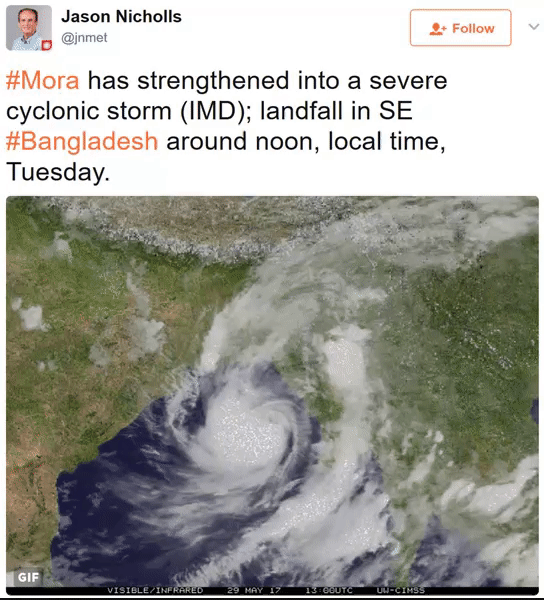73 F. average high on May 30.
79 F. high on May 30, 2016 in the Twin Cities.
May 30, 1998: A devastating line of storms hits east central Minnesota. 100 mph winds rip through Scott and Dakota County. Over 500 homes are damaged in Washington County. 15,000 trees are lost in the Twin Cities metro area, and 500,000 people lose power in Minneapolis.
May 30, 1985: A tornado hits Lakefield, and the Twin Cities report 67 mph winds.

Summer Is In No Particular Hurry This Year
Forgive me for I've overslept. I went to bed in late May and awoke in mid October. Man am I groggy.
So is the atmosphere over North America, it seems. Weather systems are slow and sluggish; the circulation creeping along in slow motion, as if powered by a handful of (drained) AAA batteries; fronts and storms more prone to getting "stuck". Where have you heard that before?
The atmosphere is warming and capable of holding more water vapor, more fuel for storms. And if the weather is, in fact, slowing down, the potential for flooding goes up.
2016 brought 160 natural disasters across North America with 19 major floods in the USA; the most since records were started in 1980, according to reinsurance company Munich Re. At the rate we're going 2017 may be just as wet.
Today brings back vibrant memories of Halloween with 50s and a cooling breeze. The sun shines bright on Wednesday, with a rare and wondrous warm front by late week. 80s on Friday! The ECMWF (Euro) keeps us cool and wet next weekend; NOAA models drier & milder.
Real summer heat? 10 days away, give or take a year.
 Ditto.
I know it looks like I'm unbearably lazy. "Paul keeps cutting and
pasting the same blasted weather map into his blog!" It sure seems that
way, but that's because the weather is in a blocking/holding pattern,
one that favors wet weather east of the Rockies. Unusually cool air
spills out of Canada into the Upper Midwest and Great Lakes; more waves
of showers and T-storms pushing across New England and the Mid Atlantic.
East of Denver - when in doubt - just predict rain. Odds are you'll be
right. 84-hour NAM: NOAA and Tropicaltidbits.com.
Ditto.
I know it looks like I'm unbearably lazy. "Paul keeps cutting and
pasting the same blasted weather map into his blog!" It sure seems that
way, but that's because the weather is in a blocking/holding pattern,
one that favors wet weather east of the Rockies. Unusually cool air
spills out of Canada into the Upper Midwest and Great Lakes; more waves
of showers and T-storms pushing across New England and the Mid Atlantic.
East of Denver - when in doubt - just predict rain. Odds are you'll be
right. 84-hour NAM: NOAA and Tropicaltidbits.com.Cool Bias Continues. Just when I think we're turning a corner into summer, up pops another corner. ECMWF guidance shows a brief warm-up by late week, followed by another cool, wet and windy weekend. NOAA models are milder and drier - let's hope they verify. Twin Cities numbers: WeatherBell.
Slow Motion Warming Trend.
My confidence level is low - I really shouldn't even be showing you
this, because the GFS model has been flip-flopping solutions in recent
days. Yesterday it hinted at a warm ridge for the west coast and Pacific
Northwest, now it shows a cold, stormy trough for Seattle and Vancouver
with warmer than average temperatures east of the Rockies. Let's see if
the long-range forecast crystallizes a bit on Wednesday. Somehow I
doubt it.

Pakistan's Hottest Day Recorded in Turbat. 122F in the shade? Here's an excerpt from The Express Tribune in Pakistan: "Citizens of Turbat sweltered through the hottest day recorded in Pakistan’s history, as the mercury shot up to 53.5°C on Sunday. The temperature equalled the one measured on May 27, 2010 in Mohenjo Daro which broke a 12-year record – 53°C in Larkana on May 31, 1998...."
Cyclone Mora: Bangladesh Tries to Evacuate One Million. A staggering number of people may be impacted, and much of Bangladesh is close to sea level and extremely vulnerable to storm surge and inland flooding. Here's an update from BBC: "Bangladeshi authorities are trying to evacuate up to a million people before a powerful cyclone makes landfall. Cyclone Mora is likely to hit the eastern coast early on Tuesday, the meteorological department said. Port cities in the south-east have been asked to display the highest warning system known as "great danger level 10". Ports further west are on level 8. The cyclone formed after heavy rains in Sri Lanka caused floods and landslides that killed at least 180 people. The worst flooding in 14 years on the island has affected the lives of more than half a million people. More than 100 people remain missing..."
Satellite imagery: CIMSS, University of Wisconsin - Madison.

How Rising Seas Drowned the Flood Insurance Program. Unless you have very deep pockets and an iron-reinforced stomach I'd avoid property within a few feet of sea level. The bubble bursts when people no longer have access to the flood insurance mandated by their mortgage bankers. Climate Central reports on a growing headaches for coastal residents: "...Today, the NFIP is effectively bankrupt. It owes the U.S. Treasury nearly $25 billion – money it borrowed from federal taxpayers to cover its obligations in Sandy, Katrina (2005), and Hurricane Ike (2008). No one expects that money to be repaid. Some coastal state lawmakers are even calling for Congress to write off the massive debt, contending it is the only way the troubled insurance program, which is up for reauthorization this year, can regain its financial footing. Wiping away the debt will help. But it is only a matter of time until the next big storm drains the coffers again. Even relatively weak hurricanes cause hundreds of millions in damage, while monster storms like Katrina and Sandy cause billions. Complicating matters, the NFIP has improbably subsidized thousands of risky properties along the coast – low-lying houses that flood over and over – by charging them below-market premiums to entice them to join the program. Now the federal flood program faces no less than an existential threat. As seas rise, coastal floodplains are expected to expand, exposing more property to routine flooding, surge, and waves. By some estimates, hundreds of thousands of U.S. houses could be underwater by century’s end and a trillion dollars worth of property at risk..."
Photo credit: "Aerial photo of damaged homes along New Jersey shore after Hurricane Sandy." Credit: Greg Thompson/USFWS/flickr
.jpg)
Looming Sunset of Flood Insurance Deal Stirs Angst in Florida, Congress. Because right now U.S. taxpayers are subsidizing federal flood insurance, making it more affordable to live along the coast. Here's an excerpt from The Naples Daily News: "...Congress is considering dramatic changes to the NFIP, which has a $25 billion debt that its director says cannot be repaid. But disagreements remain over how much homeowners should be required to pay for flood insurance to make the program more solvent. The program, run by the Federal Emergency Management Agency, has traditionally charged premiums at about 40 to 45 percent of their full cost, with taxpayers subsidizing the rest. If lawmakers can't reach an agreement, a lapse in FEMA's legal authority to write new policies could disrupt real estate sales in flood-prone areas around the country..."
Miami file photo: Lynne Sladky, AP.
Photo credit: NOAA Photo Library. "When it was dedicated in 1874, the Eads Bridge in St. Louis was the first to be constructed of true steel and was touted as being “tornado-proof.” For two decades, the bridge had resisted several storms and floods, bolstering its indestructible reputation. But, on May 27, 1896, a fearsome tornado wreaked havoc across St. Louis that not even the mighty bridge could completely withstand."
Globally,
flooding is the most common disaster risk, accounting for nearly half
of all weather-related disasters during the past 20 years. Exposure and
vulnerability to flood risks are on the rise: the proportion of the
world population living in flood-prone river basins has increased about
114 percent and population exposed to coastal areas has grown 192
percent during the last decade.
"We can't afford to continue to invest in short term solutions that don't take into account how weather patterns, sea levels and land use are changing the nature and severity of flooding," said Anita van Breda, World Wildlife Fund's senior director of environment and disaster. "The traditional approaches we've used to manage flooding in the past – like sea walls and levees – in most cases, won't work in isolation for the types of floods we're likely to experience in the future."
Read more at: https://phys.org/news/2017-05-harnessing-nature.html#jCp
"We can't afford to continue to invest in short term solutions that don't take into account how weather patterns, sea levels and land use are changing the nature and severity of flooding," said Anita van Breda, World Wildlife Fund's senior director of environment and disaster. "The traditional approaches we've used to manage flooding in the past – like sea walls and levees – in most cases, won't work in isolation for the types of floods we're likely to experience in the future."
Read more at: https://phys.org/news/2017-05-harnessing-nature.html#jCp
Globally,
flooding is the most common disaster risk, accounting for nearly half
of all weather-related disasters during the past 20 years. Exposure and
vulnerability to flood risks are on the rise: the proportion of the
world population living in flood-prone river basins has increased about
114 percent and population exposed to coastal areas has grown 192
percent during the last decade.
"We can't afford to continue to invest in short term solutions that don't take into account how weather patterns, sea levels and land use are changing the nature and severity of flooding," said Anita van Breda, World Wildlife Fund's senior director of environment and disaster. "The traditional approaches we've used to manage flooding in the past – like sea walls and levees – in most cases, won't work in isolation for the types of floods we're likely to experience in the future."
Read more at: https://phys.org/news/2017-05-harnessing-nature.html#jCp
"We can't afford to continue to invest in short term solutions that don't take into account how weather patterns, sea levels and land use are changing the nature and severity of flooding," said Anita van Breda, World Wildlife Fund's senior director of environment and disaster. "The traditional approaches we've used to manage flooding in the past – like sea walls and levees – in most cases, won't work in isolation for the types of floods we're likely to experience in the future."
Read more at: https://phys.org/news/2017-05-harnessing-nature.html#jCp
Photo credit: "Siesta Beach on Siesta Key, off the coast of Sarasota, Fla., snags the No. 1 spot on Dr. Beach’s annual Top 10." (Chris O'Meara/AP).

TODAY: Mostly cloudy, few showers and sprinkles. Winds: NW 10-20. High: near 60
TUESDAY NIGHT: Partial clearing. Low: 47
WEDNESDAY: Ring the church bells! Bright sunshine. Winds: NW 8-13. High: 71
THURSDAY: Partly sunny, more humid. Winds: S 8-13. Wake-up: 55. High: 78
FRIDAY: Some sun, sticky. T-storm late. Winds: SE 7-12. Wake-up: 62. High: 82
SATURDAY: Cooler, showers and T-storms. Winds: NE 10-20. Wake-up: 58. High: 66
SUNDAY: Cool with clouds and showers. Winds: NE 10-15. Wake-up: 53. High: 59
MONDAY: Intervals of sun, getting better. Winds: E 5-10. Wake-up: 48. High: 64
Climate Stories...
Photo credit: "New Hampshire's moose population is on the decline as warmer temperatures allow ticks to flourish later into the winter." Credit: Peter Pekins/University of New Hampshire.
.jpg)
What Happens If The U.S. Withdraws From the Paris Climate Change Agreement. CBS News reports: "...Scientists said it would worsen an already bad problem and make it far more difficult to prevent crossing a dangerous global temperature threshold. Calculations suggest it could result in emissions of up to 3 billion tons of additional carbon dioxide in the air a year. When it adds up year after year, scientists said that is enough to melt ice sheets faster, raise seas higher and trigger more extreme weather. "If we lag, the noose tightens," said Princeton University climate scientist Michael Oppenheimer, co-editor of the peer-reviewed journal Climatic Change..."

Photo credit: "Buildings with green roofs, like this one in Stuttgart, Germany, don't use as much energy as standard buildings and emit fewer greenhouse gasses." Photo by Diane Cook and Len Jenshel, National Geographic Creative.
Photo credit: "Banner created by Alliance for Climate Education."
What the U.S. Could Learn From the Dutch on Climate Change. We're already taking advantage of their sea walls and levee technology as seas continue to rise and nuisance flooding increases. But there are other lessons, according to MIT Technology Review: "Earlier this month, the Netherlands completed one of the largest offshore wind farms in the world, as an accelerating wind boom finally helps the country make real progress on its renewable energy goals. The 600-megawatt Gemini wind park, operating 150 turbines in the North Sea, will serve some 1.5 million citizens. Several other major offshore wind farms are under development as well, which will collectively push total wind capacity to nearly 4.5 gigawatts by 2023 (see “The Wind Fuels the North Sea’s Next Energy Boom”). “As a country we were heavily dependent on fossil fuels, and our way to renewables has been bumpy,” Sharon Dijksma, the nation’s minister for the environment, told MIT Technology Review this week. “So this government decided that we needed to step up the pace...”
Photo credit: "The Gemini wind farm includes 150 turbines in the North Sea."
No comments:
Post a Comment